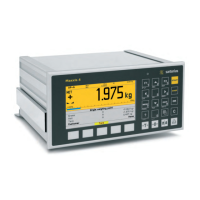
Do you have a question about the Minebea Sartorius Intec Maxxis 4 PR 5500 and is the answer not in the manual?
| Manufacturer | Minebea Intec |
|---|---|
| Product Category | Controller |
| Product Name | Maxxis 4 PR 5500 |
| Housing material | Stainless steel |
| Protection type | IP65 |
| Application | Weighing applications |
| Display | LCD |
| Interfaces | Ethernet, RS232 |
| Operating Temperature | -10 °C to +40 °C |
Explains symbols used in the manual for warnings, notes, and user guidance.
Covers essential checks and procedures before the device is put into operation.
Outlines procedures for repairs, maintenance, and handling of static-sensitive components.
Details key features like accuracy, response times, housing, and connectivity options.
Describes the physical dimensions and installation requirements for the device housing.
Explains the layout and function of the display, keys, and indicators.
Illustrates all available ports and interfaces for connecting external devices and modules.
Lists and describes various optional interface and fieldbus cards for expanding functionality.
Covers essential steps for preparing the installation site and securing components.
Identifies key components and their locations on the main board.
Lists and describes various optional accessories and their specifications.
Technical details and connection diagrams for the dual RS-485 interface card.
Details of the digital I/O card with 4 inputs and 4 outputs.
Specifications and connection details for the ProfiBus-DP fieldbus card.
Specifications and connection details for the ProfiNet I/O fieldbus card.
Explains how the device handles power interruptions and different startup modes.
Guides users on connecting and configuring the device using remote access tools.
Covers setting up and managing user accounts with different access levels.
Overview of the device's main menu structure for configuration.
Detailed procedures for calibrating the internal weighing system.
Setup procedures for connecting and configuring xBPI scales.
Calibration process for Pendeo Truck digital load cells.
Configuration of network settings like IP address, hostname, and DHCP.
Configuration steps for an internal weighing point, including calibration.
Configuration procedures for connecting and setting up an xBPI scale.
Adjustments for display color and luminance.
How to activate licenses for functions and application programs.
Access to essential functions for maintaining the device's operational status.
Procedures for backing up configuration and data to various media.
How to restore backed-up data from SD card, USB stick, or shared folders.
Functionality to export device data to external media in XML format.
How to import data files (XML format) from external media into the device.
Management of Alibi memory records, including export and clearing.
Operations related to the SD card, such as formatting and cleaning backups.
Generating a report file containing system status, logs, and configuration for technical support.
Correct procedure for powering down the device, including data saving and battery deactivation.
Methods for updating the device's firmware and application software.
Restoring the device to its original factory configuration.
Procedures for testing the device's display, keyboard, and I/O cards.
Accessing device functions through a web browser via network connection.
Functions for managing the Alibi memory, including erasing and overwriting records.
Accessing the basic input/output system for system recovery and startup options.
Overview of the J-Bus/ModBus protocol and its supported functions for device communication.
Details the telegram structure and specifications for ModBus-RTU communication via serial interface.
Explains ModBus-TCP/UDP communication via the network interface, including telegram structure and comparison.
Describes the specific ModBus functions (e.g., read/write bits, words) and their command/reply structures.
Lists and explains error messages generated during ModBus communication.
Details commands for reading and manipulating weight data, including parameters and error messages.
Describes commands for interacting with the SPM (Serial Peripheral Module).
Information about the lithium battery for date/time backup and its replacement.
Instructions on how to clean the device safely, including warnings about moisture and cleaning agents.
Lists errors related to the weighing electronics and their possible causes.
Specific error codes and causes for communication issues with xBPI scales.
Error messages associated with Pendeo load cells and their troubleshooting.
Error messages that may occur during the calibration process, categorized by function.
Provides overall technical specifications valid after warm-up.
Specifies operating and storage conditions like temperature, moisture, and elevation.
Lists EMC compliance data and immunity test levels for signal lines and inputs.
Physical characteristics of the device's construction and dimensions.
Shows an example of the device's configuration settings as a printed report.
Explains the function and status indicated by the LEDs on the device and its modules.
Describes the procedure for coding connectors for plug-in cards.
Safety information and procedures for replacing optional and fieldbus cards.
Steps for transferring data and settings to a new device, including SIL chip and SD card considerations.
Procedures for safely replacing the SD card, including data export and import.